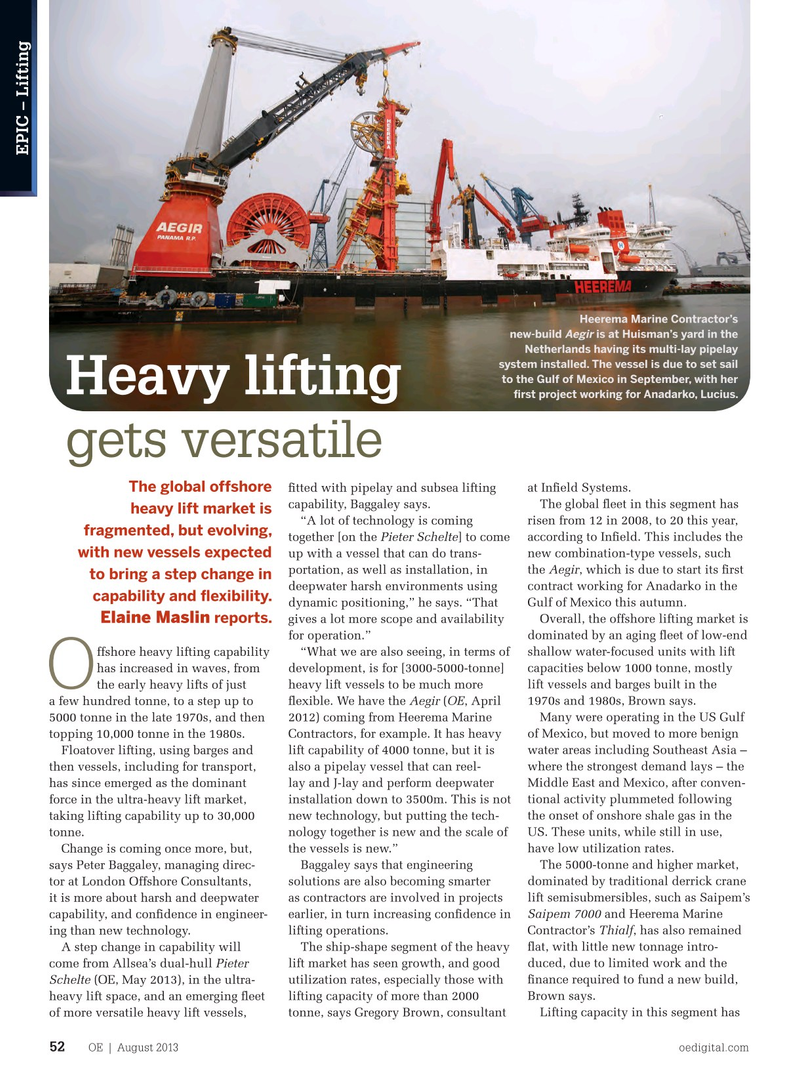
Page 50: of Offshore Engineer Magazine (Aug/Sep 2013)
Read this page in Pdf, Flash or Html5 edition of Aug/Sep 2013 Offshore Engineer Magazine
EPIC – Lifting
Heerema Marine Contractor’s new-build is at Huisman’s yard in the Aegir
Netherlands having its multi-lay pipelay system installed. The vessel is due to set sail to the Gulf of Mexico in September, with her
Heavy lifting frst project working for Anadarko, Lucius.
gets versatile
The global offshore ftted with pipelay and subsea lifting at Infeld Systems. capability, Baggaley says. The global feet in this segment has heavy lift market is “A lot of technology is coming risen from 12 in 2008, to 20 this year, fragmented, but evolving, together [on the Pieter Schelte] to come according to Infeld. This includes the up with a vessel that can do trans- new combination-type vessels, such with new vessels expected portation, as well as installation, in the Aegir, which is due to start its frst to bring a step change in deepwater harsh environments using contract working for Anadarko in the capability and fexibility. dynamic positioning,” he says. “That Gulf of Mexico this autumn. gives a lot more scope and availability Overall, the offshore lifting market is
Elaine Maslin reports. for operation.” dominated by an aging feet of low-end ffshore heavy lifting capability “What we are also seeing, in terms of shallow water-focused units with lift has increased in waves, from development, is for [3000-5000-tonne] capacities below 1000 tonne, mostly the early heavy lifts of just heavy lift vessels to be much more lift vessels and barges built in the
O a few hundred tonne, to a step up to fexible. We have the Aegir (OE, April 1970s and 1980s, Brown says. 5000 tonne in the late 1970s, and then 2012) coming from Heerema Marine Many were operating in the US Gulf topping 10,000 tonne in the 1980s. Contractors, for example. It has heavy of Mexico, but moved to more benign
Floatover lifting, using barges and lift capability of 4000 tonne, but it is water areas including Southeast Asia – then vessels, including for transport, also a pipelay vessel that can reel- where the strongest demand lays – the has since emerged as the dominant lay and J-lay and perform deepwater Middle East and Mexico, after conven- force in the ultra-heavy lift market, installation down to 3500m. This is not tional activity plummeted following taking lifting capability up to 30,000 new technology, but putting the tech- the onset of onshore shale gas in the tonne. nology together is new and the scale of US. These units, while still in use,
Change is coming once more, but, the vessels is new.” have low utilization rates. says Peter Baggaley, managing direc- Baggaley says that engineering The 5000-tonne and higher market, tor at London Offshore Consultants, solutions are also becoming smarter dominated by traditional derrick crane it is more about harsh and deepwater as contractors are involved in projects lift semisubmersibles, such as Saipem’s capability, and confdence in engineer- earlier, in turn increasing confdence in Saipem 7000 and Heerema Marine ing than new technology. lifting operations. Contractor’s Thialf, has also remained
A step change in capability will The ship-shape segment of the heavy fat, with little new tonnage intro- come from Allsea’s dual-hull Pieter lift market has seen growth, and good duced, due to limited work and the
Schelte (OE, May 2013), in the ultra- utilization rates, especially those with fnance required to fund a new build, heavy lift space, and an emerging feet lifting capacity of more than 2000 Brown says. of more versatile heavy lift vessels, tonne, says Gregory Brown, consultant Lifting capacity in this segment has
OE | August 2013 oedigital.com 52 052_OE0813_EPIC3_lifting.indd 52 7/22/13 12:39 AM

 49
49

 51
51